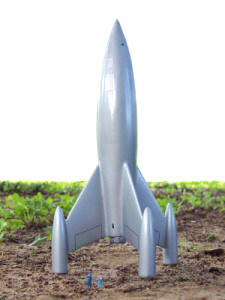Venus
 Venus is a hot, swampy world. It is the second planet from the Sun, with a nearly circular orbit having a period of 225 days. Its rotation is retrograde (in the opposite sense of the Earth and all other planets except Uranus). The entire surface is always covered by a thick layer of clouds. This cloud layer reflects a significant portion of the Sun's radiation, preventing Venus from becoming an uninhabitable oven. Its surface gravity is approximately five-sixths of Earth and it boasts an oxygen-rich atmosphere thanks to its dense, planetwide vegetation. Newly arrived colonists from Earth typically experience a "light, euphoric feeling" as a result of these conditions.
Venus is a hot, swampy world. It is the second planet from the Sun, with a nearly circular orbit having a period of 225 days. Its rotation is retrograde (in the opposite sense of the Earth and all other planets except Uranus). The entire surface is always covered by a thick layer of clouds. This cloud layer reflects a significant portion of the Sun's radiation, preventing Venus from becoming an uninhabitable oven. Its surface gravity is approximately five-sixths of Earth and it boasts an oxygen-rich atmosphere thanks to its dense, planetwide vegetation. Newly arrived colonists from Earth typically experience a "light, euphoric feeling" as a result of these conditions.
I can tell from here . . . what the inhabitants of Venus are like; they resemble the Moors of Granada; a small black people, burned by the sun, full of wit and fire, always in love, writing verse, fond of music, arranging festivals, dances, and tournaments every day. - Quoted in National Geographic, June, 1975
Venus was first visited by the Soviet spaceship Venera I in 1970. Prior to the Soviet mission many scientists had expected Venus to be habitable, but they were shocked to learn about the presence of intelligent, human life. Whether this is a remarkable example of convergent evolution or the Venerians share a common ancestory with Terrestrial humans remains a matter for speculation. Unions between colonists and Venerians have reportedly produced healthy, fertile offspring, confirming that the races are genetically compatable. The Venerians are an attractive people who outwardly resemble Polynesians, except that their feet are webbed and their eyes are equipped with an inner eyelid. Their dark, oily skin provides protection against moisture and the not insignificant amount of ultraviolet radiation that manages to penetrate the dense Venerian cloud layer. They spend much of their time in the water and are capable of holding their breath for long periods like dolphins.
The Venerians are a tribal, male dominated society. Marriage as we know it is unknown and females are regarded as property, albeit valuable. Social standing among the males is reckoned by the number of females they keep in their huts. This social order probably evolved as a result of the higher mortality rate among the males, who serve as the hunters and warriors, and the higher female birthrate. Venerian female births outnumber male births by roughly three to one. Their average lifespan is only about forty Earth years, but this is mostly due to the harsh environment.
Venerian native technology is roughly equivalent to early Bronze Age. They possess hand weapons, simple tools, woven fabrics and a complex written language. Venerians are skilled musicians and artisans, and their ornate carvings, elaborate tapestries and delicate pottery are highly prized by collectors and art museums. Due to a general lack of suitable building materials and no need for more permanent structures, their architecture is normally limited to straw huts. The Venerians have erected a few large mud-brick buildings in the various "trade towns" that sprang up near the North Pole since the arrival of colonists from Earth, but these are not found elsewhere. Having never seen the stars they have no knowledge of astronomy, although old tapestries record how their first ancestors came from "a place beyond the sky". The Venerians are hunters and gatherers with little use for agriculture, and attempts by early colonists to use them for plantation work proved woefully unsuccessful. This has regularly been used as a "justification" for the contract labor system.
Venus is a colony. The colonists breathe the air of Venus, eat its food, and expose their skins to its climate and natural hazards. Only the cold polar regions - approximately equivalent in weather conditions to an Amazonian jungle on a hot day in the rainy season - are tenable by terrestrials, but here they slop barefooted on the marshy soil in true ecological balance. - From "Logic of Empire" by Robert A. Heinlein
While the Venerian heat and humidity are oppressive, the climate is tolerable in the polar regions and most settlers are able to adapt after a week or so. Some early colonists suffered from severe dermal and respiratory infections after exposure to native spores and bacteria, but with few exceptions humans are thankfully immune to Venerian diseases. Terrestrial floura is another matter, as most foodcrops from Earth will rapidly succumb to a variety of airborne fungi. Fortunately some native crops, such as "swamp beans", have proven tasty and nutritious to humans. The demand for exports of non-carcinogenic "tobacco" and fungi-resistant food crops skyrocketed after the "Orange Blight" decimated Terrestrial crops, and other Venerian plants have proven to be important sources of pharmaceuticals.
Since the mid-80s almost all immigrants to Venus have settled at one of the North Polar Colonies ("Free Venus"). The lone, isolated South Polar Colony ("Red Venus") was established by Russian Communists prior to the collapse of the Soviet Union and has reportedly remained under Communist control.
BACK TO